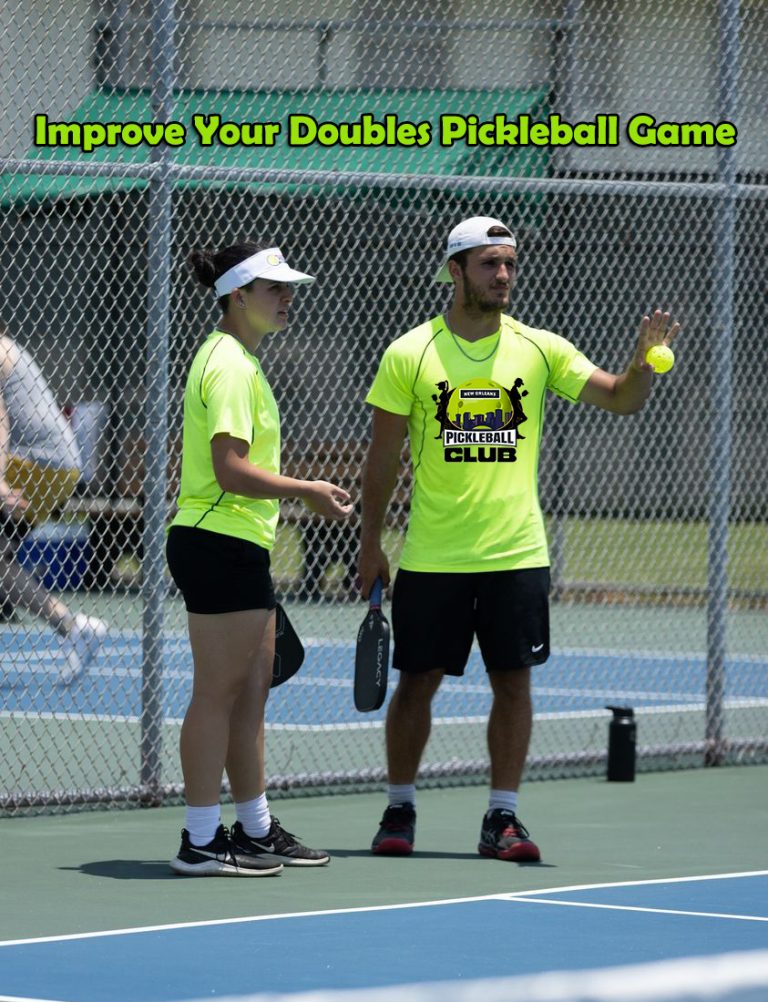The Serve: The Most Important Shot in Pickleball
The most important shot in pickleball – The serve in pickleball is arguably the most important shot in the game for several reasons. Let’s delve into why this is the case.
Most Important Shot in Pickleball: Initiating Control
First Point of Contact: The serve is the first shot of every point, meaning it’s the initial opportunity to assert control. A well-placed serve can immediately put your opponent on the defensive, setting the tone for the rally. Research shows that the first few shots in any rally are critical in determining the outcome of the point. By starting strong with an effective serve, players can tilt the rally in their favor from the get-go.
Creating Pressure
Forcing Errors: A powerful or strategically placed serve can force opponents into making mistakes. Whether it’s hitting a return out of bounds or into the net, a strong serve can directly result in points. High-level players often emphasize the importance of a consistent and varied serves to keep opponents guessing and off-balance.
Setting Up the Third Shot
Third Shot Advantage: The serve directly influences the quality of the third shot. A deep, powerful serve can push opponents back, giving the serving team more time and space to execute an effective third shot drop or drive. The third shot is a pivotal moment in pickleball strategy, and a good serve makes this shot easier and more effective.
Psychological Impact
Mental Edge: A strong serve can intimidate opponents, especially if they struggle with returns. Consistently powerful serves can erode an opponent’s confidence, giving the server a psychological edge. Sports psychologists often highlight the importance of the serve as a weapon not just physically, but mentally, in competitive matches. The serve can create psychological pressure on the returner, especially in high-stakes matches. Knowing that the serve is consistently strong can force returners to overthink, leading to mistakes. A strong serve not only tests the returner’s physical skills but also their mental resilience.
Rule Dynamics
Scoring Rules: Given that points can only be scored by the serving team, the serve becomes crucial. Maximizing the effectiveness of serves can lead directly to scoring opportunities. This scoring rule places additional importance on the serve compared to other shots, as it is the only shot that can initiate the chance to score (unless the match is played using Rally Scoring).
Serve Variations
Versatility and Adaptation: The serve offers a variety of styles and spins that can be employed to disrupt an opponent’s rhythm. From power serves to spin serves, the variations are numerous and can be tailored to exploit opponents’ weaknesses. Mastering different serve techniques can make a player significantly more versatile and difficult to predict, giving them an upper hand in matches.
Serve as a Tool for Dictating Play
Initiating Strategy: While it’s true that the returner has an immediate advantage by being able to move to the net quickly, a well-placed serve can disrupt this plan. By serving deep and with precision, the server can force a weak return, setting up an easier third shot.
A strategic serve can push the returner back, making it more challenging for them to execute a controlled return and advance to the net efficiently.
Creating Opportunities
Weak Returns: Even at higher levels, a serve with excellent placement and spin can cause difficulties. A return that is less than perfect gives the serving team a chance to dictate the play with their third shot. By serving to specific areas such as the opponent’s backhand or deep into the corners, servers can increase the likelihood of receiving a return that sets them up for a winning strategy.
Variety and Unpredictability
Serve Variations: Incorporating a variety of serves (topspin, slice, and flat serves) can keep opponents guessing. This unpredictability makes it harder for the returner to settle into a rhythm. A well-disguised serve can lead to outright service winners or weak returns, even at the professional level.
Tactical Advantage
Setting Up the Point: While it’s true the serving team must stay back until the third shot, a strategic serve can set up a favorable scenario for the third shot. A deep serve can make the returner hit a high, floaty return, giving the serving team an easier third shot to transition to the net. The serve is the first step in executing a well-planned point, making it crucial for setting up the subsequent shots.
Serve Metrics
Statistical Evidence: Data from high-level matches often show that players who can serve effectively win more points on their serve. The ability to serve well correlates with holding serve and, thus, controlling the match. Even slight improvements in serve quality can lead to significant advantages over the course of a match, especially in tightly contested games.
Controlled Environment
Both the serve in pickleball and a free throw in basketball are performed without immediate pressure from the opponent, allowing for precise execution and technique refinement. This similarity highlights the importance of muscle memory and consistent practice. Just as a basketball player can perfect their free throw through repetition, a pickleball player can develop a reliable and effective serve by drilling regularly. The controlled environment of both actions also emphasizes the mental aspect, requiring concentration and focus to execute successfully under varying conditions.
Repetition and Practice
Players can repeatedly practice these actions to build consistency and proficiency, which can translate to a significant advantage during actual gameplay. Any other shot in pickleball involves the potential of many different factors to come into play. But the serve only involves strategy and technique without quick thinking. You can plan and execute the serve without the immediacy of diagnosing the next shot quickly. This unique aspect of the serve allows players to focus on perfecting their form and placement, making it a reliable and effective weapon in their arsenal.
Set-Up for the Next Play
A well-executed serve can set up favorable conditions for the subsequent shots, similar to how a successful free throw can influence the game’s momentum and strategy.
Mental Focus
Both the serve in pickleball and the free throw in basketball require a high level of mental concentration and focus, underscoring their importance in their respective sports. The player must block out distractions and maintain a calm, focused mindset to execute the serve or free throw effectively. This mental aspect of the serve is crucial, as maintaining composure and confidence can significantly impact performance during high-pressure situations.
Strategic Variety
While a good serve sets the stage, the subsequent shots—like the third shot drop or drive—often determine the rally’s outcome. These shots require more adaptation to the opponent’s play, showcasing the broader strategic depth beyond the serve. However, the serve is the building block of constructing the point from the onset. A well-executed serve lays the foundation for the entire rally, creating opportunities and setting the tone for subsequent shots. By starting with a strong serve, players can initiate their strategy and maintain control throughout the point.
Serve as a Weapon: The Most Important Shot in Pickleball
Direct Point-Scoring Potential: A well-executed serve has the potential to score outright points or set up easy put-aways. This direct impact on the score is a unique attribute of the serve.
While the return is reactive, the serve is proactive, allowing the server to take the initiative and control the pace of the game.
Evolution of the Game
Modern Techniques and Training: As pickleball evolves, the serve has become more of a weapon with players developing techniques to increase serve speed, spin, and placement accuracy. This evolution underscores the serve’s growing importance in competitive play.
Advanced serve techniques can give players a significant advantage, even at the highest levels of the game, demonstrating the serve’s crucial role.
Advanced Tips: The Most Important Shot in Pickleball
For those looking to refine their serving skills even further, consider these advanced tips:
- **Vary the Spin:** Incorporate different spins such as topspin, backspin, and sidespin to keep your opponents guessing.
- **Mix Up the Pace:** Alternate between fast, powerful serves and slower, more controlled serves to disrupt your opponent’s timing.
- **Target Weaknesses:** Serve to your opponent’s weaker side or exploit known weaknesses in their return game.
- **Use the Element of Surprise:** Occasionally use an unexpected serve, like a short, soft serve, to catch your opponent off guard.
While the return is undeniably important and a critical part of constructing the point, the serve remains the foundational shot that can dictate the course of the rally. Its ability to create immediate pressure, establish strategic control, and directly influence the point’s outcome underscores its status as the most important shot in pickleball.
Drilling and Muscle Memory
To truly master the serve, consistent practice and drilling are essential. Developing muscle memory through repetition allows players to execute serves with precision and confidence during matches. Drilling various serve types—topspin, slice, and flat serves—ensures that players can adapt to different match situations and opponents.
Placement, Depth, Speed, Angle, and Spin
The effectiveness of a serve is often determined by its placement, depth, speed, angle, and spin. A well-placed serve can force the opponent into a weak return, while a deep serve can push them back, making it difficult to advance to the net. Varying the speed and angle keeps opponents guessing, and incorporating spin can make the ball unpredictable and harder to return.
- Placement: Aim for specific spots on the court to target your opponent’s weaknesses.
- Depth: Deep serves push opponents back, giving you more time to prepare for the third shot.
- Speed: Varying the speed of your serves can disrupt your opponent’s timing.
- Angle: Serving at different angles can force your opponent out of position.
- Spin: Using topspin, slice, or sidespin can make the ball’s trajectory more difficult to predict.
The Most Important Shot in Pickleball
The serve in pickleball is not just a means to start the point; it is a strategic weapon that can control the flow of the game. By mastering the serve, players can create immediate pressure, set up advantageous shots, and gain a psychological edge over their opponents. Consistent practice, attention to detail, and a varied serve arsenal are key to making the serve the most important shot in pickleball.








One Comment